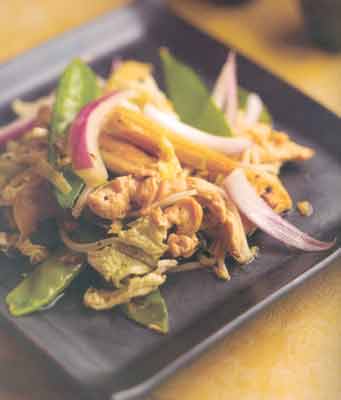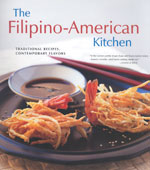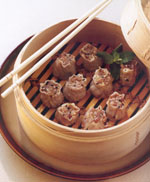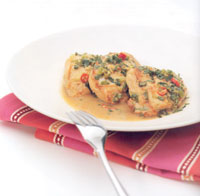Pan Asian
East meets West and everywhere in between.
Asian food has traveled far and wide, mixing with flavors and styles from around the world to form dishes that transcend translation.
All you need is a wok to reap the benefits.
So make a list for the nearest Triangle Asian market and try some of the intercontinental fare from the following cookbooks:
"Honga's Lotus Petal"
"The Filipino-American Kitchen"
"300 Best Stir-Fry Recipes"
"Japanese Foods That Heal"
“Honga's Lotus Petal”
By Honga Im Hopgood,
Published by Gibbs Smith

Garlic Lemon Chicken
2 tablespoons high-temperature cooking oil
½ onion, diced
4 cloves garlic, minced
2 teaspoons minced ginger
2 boneless chicken breasts, cut into bite-size
pieces
2 stalks celery, sliced
1 8-ounce can baby corn, drained
1 cup snow peas
¼ cup fish sauce
1 lemon, juiced
¼ cup honey
¼ cup chicken stock or water
2 cups sliced bok choy or Napa cabbage
½ teaspoon black pepper
1 cup mung bean sprouts
Preheat a wok or skillet over high heat until it just begins to smoke. Drizzle the oil down the sides of the wok and immediately add onion, garlic, ginger and chicken. Saute, stirring constantly, 2 minutes.
Add the celery, baby corn and snow peas. Allow the vegetables to caramelize before stirring.
When steam begins to rise, stir and then add the fish sauce and lemon juice.
Mix in the honey, and then stir in the stock.
Add the bok choy. Stir for 1 more minute, until the chicken is done.
Sprinkle with black pepper and turn off the heat. Stir in the bean sprouts, allowing them to warm from the remaining heat in the wok.
Serve with rice.
Makes 2 servings.
Grilled Salmon and Bok Choy
3 tablespoons olive oil
2 teaspoons sea salt
2 teaspoons black pepper
4 six-ounce fillets wild salmon
4 baby bok choy
Preheat a grill to high. In a small bowl, mix together the oil, salt and black pepper. Rub some of the oil mixture onto the salmon.
Cut each bok choy in half lengthwise from root to green leaves. Rub the remaining oil mixture onto the bok choy.
Place the salmon on the grill. Grill 2 minutes and flip.
At this time, place the bok choy on the grill, turning it over when it begins to wilt and roast.
Grill the salmon another minute and remove.
Makes 4 servings.
 “The Filipino-American Kitchen”
“The Filipino-American Kitchen”By Jennifer M. Aranas,
Published by Tuttle Publishing
Pork and Ginger Dumplings
1 pound lean ground pork
1 clove garlic
1½ teaspoons peeled and minced fresh ginger
2 tablespoons oyster sauce
1 tablespoon soy sauce
Pinch of freshly ground
black pepper
½ cup finely shredded
Napa cabbage
1 package round dumpling
wrappers
Dipping Sauce
2 tablespoons soy sauce
1 teaspoon mashed
roasted garlic
¼ teaspoon rice vinegar
¼ teaspoon dried red
pepper flakes
To make the filling, combine the pork, garlic, ginger, oyster sauce, soy sauce and pepper in a large bowl and mix very well until the seasonings are distributed throughout the meat.

Add the cabbage and mix again to evenly distribute through the meat.
To form the dumplings, start by very lightly moistening the edges of a dumpling wrapper using a pastry brush and water.
Turn the wrapper over and, on the dry side, spread 1 heaping teaspoon of pork filling evenly toward the edge using the back of your spoon.
If you are right-handed, place the tips of your left thumb and forefinger together to form a circle. (Use your right hand if left-handed.)
Center the dumpling wrapper, meat side up, on top of your fingers so that the center of the wrapper is in the circle of your fingers.
With your spoon, gently push the center of the wrapper into the circle of your fingers while tightening your fingers around the dumpling to give it its tulip shape, leaving the top of the dumpling open.
Take a little more filling and pack it in the top to give it more shape if necessary, and smooth the meat.
Place the dumpling on a tray lined with parchment or wax paper.
Continue with the remaining dumplings. It is important that the dumplings are not touching each other on the tray; they will stick together.
To cook the dumplings, place them in a steamer and steam 8 to 12 minutes, until the dumplings are firm when gently squeezed with tongs.
To make the dipping sauce, combine all the sauce ingredients together in a small dish.
Serve immediately with dipping sauce.
Makes 30 dumplings.
Chicken in Peanut Sauce

1 tablespoon olive oil
1 teaspoon annatto seeds
2 pounds chicken breasts, skin removed
2 green onions, chopped
2 cloves garlic, minced
1 small Thai chile, chopped
1 tablespoon rice wine
2 teaspoons coconut vinegar
1 tablespoon rice flour
1½ cups chicken stock
2 tablespoons creamy peanut butter
1 tablespoon fish sauce
1 tablespoon chopped fresh coriander (cilantro) leaves
2 tablespoons coarsely ground roasted peanuts
Heat the olive oil in a large saute pan over medium heat. Add the annatto seeds. Cook and stir 4 to 5 minutes, until the oil becomes rust colored. Use a spoon to remove and discard the seeds.
Increase the heat to medium-high. When the oil is smoking, add the chicken breasts, being careful not to overcrowd the pan. Brown the chicken on both sides, 4 to 5 minutes per side.
Remove the chicken from the pan and set it on a plate.
To make the sauce, add the green onions, garlic and chile to the pan. Saute 1 minute, being careful to not burn the vegetables.
Deglaze the pan with the rice wine and vinegar, scraping any browned bits off the bottom of the pan.
Dissolve the rice flour in a large cup with the chicken broth. Add the mixture to the pan with the peanut butter and fish sauce.
Return the chicken breasts to the pan with the sauce. Let the mixture simmer, uncovered, 20 to 25 minutes, until the sauce thickens and the chicken is fully cooked.
Transfer the chicken to a serving dish and pour the sauce on top.
Sprinkle over the fresh coriander leaves and ground peanuts to garnish.
Makes 4 servings.
 “300 Best Stir-Fry Recipes”
“300 Best Stir-Fry Recipes”By Nanci McDermott, Published by Robert Rose Inc.
Stir-Fried Shrimp With Olives and Smoked Paprika
1 tablespoon soy sauce
1 tablespoon dry sherry or rice wine
1 teaspoon paprika (preferably smoked Spanish
paprika)
½ teaspoon granulated sugar
½ teaspoon salt or to taste
2 tablespoons vegetable oil
1 tablespoon chopped garlic
2 tablespoon chopped onion or shallots
¼ cup chopped celery
12 ounces medium shrimp, peeled and de-veined
2 tablespoons coarsely chopped kalamata olives or sliced black olives
2 tablespoons chopped green onions
2 tablespoons chopped Italian parsley
In a small bowl, combine the soy sauce, sherry, paprika, sugar and salt. Stir well and set aside.
Heat a wok or a large, deep skillet over high heat.
Add the oil and swirl to coat the pan. Add the garlic and onion and stir well, until fragrant, about 15 seconds.
Add the celery and stir well. Cook, stirring once, 30 seconds.
Add the shrimp, making sure it is spread into a single layer. Cook, undisturbed, about 1 minute, or until most of the edges turn pink. Stir well and cook on the other side, about 30 seconds more.
Add the soy sauce mixture, pouring it around the sides of the pan and stir well. Cook, stirring occasionally, about 1 minute more, or until the shrimp are cooked through and everything combines to make a thin, dark sauce.
Add the olives and stir.
Remove the mixture from the heat and stir in the green onions and parsley.
Transfer to a serving plate. Serve hot or warm.
Makes 4 servings.
Butternut Stir-Fry With Peppers and Peas
2 tablespoons vegetable oil
1 tablespoon chopped fresh gingerroot
2 cups cubed, peeled butternut squash
cup diced red bell pepper
cup frozen tiny peas
2 tablespoons water
3 tablespoons barbecue sauce
1 teaspoon salt
Heat a wok or a large, deep skillet over high heat. Add the oil and swirl to coat the pan.
Add the ginger and stir well about 15 seconds, until fragrant.
Add the squash, spreading it into a single layer. Cook, undisturbed, 1 minute. Cook, stirring often, until the squash is browning lightly around the edges, about 2 minutes more.
Push the squash aside and add the red pepper and peas. Scoop the squash on top of the vegetables. Add the water, pouring it in around the edges of the pan.
When everything is sizzling, add the barbecue sauce and salt. Cook, stirring once or twice, until the vegetables are tender and evenly coated with sauce, 1 to 2 minutes more.
Transfer the mixture to a serving plate. Serve hot or warm.
Makes 4 servings.
By John & Jan Belleme, Published by Tuttle Publishing
Udon With Shiitake
2 tablespoons extra virgin olive oil
Salt and freshly ground black
pepper, to taste
8 ounces dried udon noodles
2 cups fresh shiitake mushroom caps, sliced
1 tablespoon minced garlic
4 tablespoons finely chopped fresh parsley
1/3 cup very thinly sliced fresh basil leaves
1 teaspoon balsamic vinegar
2 green onions, thinly sliced
1/3 cup slivered almonds or pine nut, lightly toasted
In a large bowl, combine 1 tablespoon of the olive oil and a pinch of salt and pepper and set aside.
In preparation for cooking the udon, add 8 to 10 cups water to a large pot and bring to a full rolling boil. Add the udon to the rapidly boiling water and stir to prevent the noodles from sticking together.
Immediately heat the remaining tablespoon of oil in a large skillet and toss in the shiitake and garlic and a pinch each of salt and pepper. Saute over medium heat 2 to 3 minutes.
Stir in the parsley and basil and cook 1 to 2 minutes more.
Add the balsamic vinegar and stir. Remove the mixture from the heat.
When the udon is tender but still firm, after about 7 to 9 minutes, drain and rinse the noodles. Stir in the mixture of oil, salt and pepper.
Immediately add the udon to the shiitake mixture, stir well, and transfer the noodles and vegetables to a serving bowl.
Garnish with the green onions and nuts. Serve immediately.
Makes 2 to 3 servings.
Curried Vegetables With Dried Tofu
4 pieces freeze-dried tofu
1 tablespoon extra-virgin olive oil
2 cloves garlic, minced
1 onion, chopped
2 carrots, cut into bit-size chunks
2 potatoes, peeled and diced
1 teaspoon sea salt
4 teaspoons curry powder
2 teaspoons ground cumin
4 cups vegetable stock
1 bay leaf
2 cups small broccoli florets
2 teaspoons shoyu (Japanese soy sauce)
1 teaspoon mirin
3 tablespoons crushed kuzu starch (available at natural food stores)
Reconstitute the dried tofu by soaking it in lukewarm water 5 minutes. Repeatedly dampen the tofu and squeeze out the excess water several times, until the water that comes out is no longer milky. Slice the tofu into small cubes.
Heat the oil in a large skillet over medium heat and saute the garlic and onion 2 to 3 minutes, or until the onion is translucent.
Add the carrots and potatoes and saute 2 to 3 minutes more.
Add the salt, curry and cumin and saute briefly, and then add 3 cups of the stock, the bay leaf and dried tofu. Cover and simmer 20 minutes.
Add the broccoli and the remaining stock and simmer, covered, 5 minutes, or until the broccoli is tender-crisp.
Stir in the shoyu and mirin.
Thoroughly dissolve the kuzu in 3 tablespoons cold water and add it to the mixture while stirring. Continue stirring gently a minute or two until the sauce thickens. Simmer 1 minute more.
Serve over a bed of rice.
Makes 4 servings.
